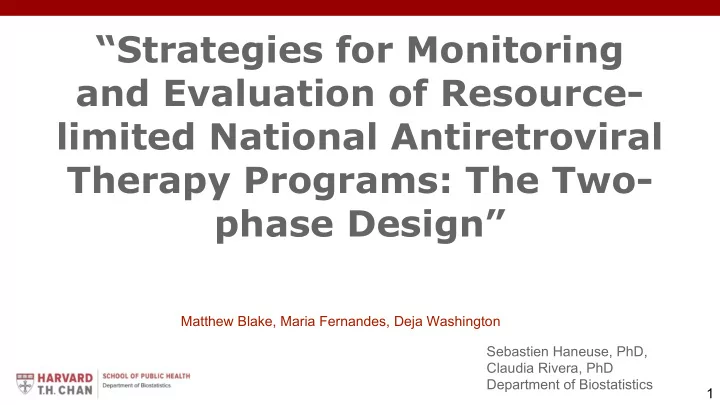

“Strategies for Monitoring and Evaluation of Resource- limited National Antiretroviral Therapy Programs: The Two- phase Design” Matthew Blake, Maria Fernandes, Deja Washington Sebastien Haneuse, PhD, Claudia Rivera, PhD Department of Biostatistics 1
Background ● Malawi, Africa high number of HIV/Aids cases (one million, Dr. Harries et al) ● Implementation of National Antiretroviral Treatment (ART) Programs ● Focusing on 2005-2007 timely systems for Malawi, Africa Monitoring and Evaluation (M&E) 2
Background ● Antiretroviral treatment (ART) programs rely on monitoring and evaluation (M&E) ● Collected data: ○ Planning ○ Managing ○ Addressing potential problems ○ epidemiologic research. 3
Challenges Complete data (ideal) Children Adults Total ● Comprehensive data collection is ● expensive Male 3 6 9 World Health Organization ● (WHO) devised relying on Female 7 4 11 “quarterly clinic-cohorts” aggregated data Total 10 10 20 Aggregated data may result in ● ecological bias 4
Challenges Complete data (ideal) Children Adults Total ● Comprehensive data collection is ● expensive Male 3 6 9 World Health Organization ● (WHO) devised relying on Female 7 4 11 “quarterly clinic-cohorts” aggregated data Total 10 10 20 Aggregated data may result in ● ecological bias 4
Dogma of Data Collection 5
Dogma of Data Collection 5
Dogma of Data Collection Individual Clinic Paper-Based Master Cards 5
Dogma of Data Collection Quarterly-Clinic Cohort Data Collected Individual Clinic Paper-Based By Ministry of Health Master Cards *aggregated 5
Dogma of Data Collection Quarterly-Clinic Cohort Data Collected Individual Clinic Paper-Based By Ministry of Health Master Cards *aggregated 5
Dogma of Data Collection Quarterly-Clinic Cohort Data Collected Individual Clinic Paper-Based By Ministry of Health Master Cards *aggregated 5
Dogma of Data Collection Quarterly-Clinic Cohort Data Collected MoH Database; ready for analysis Individual Clinic Paper-Based By Ministry of Health Master Cards *aggregated 5
Dogma of Data Collection Quarterly-Clinic Cohort Data Collected MoH Database; ready for analysis Individual Clinic Paper-Based By Ministry of Health Master Cards *aggregated For the dates 04/2008-05/2009, Malawian MoH, conducted a one-time cross- sectional survey which covered: ● Demographic characteristics (age, WHO Stage, gender) ● Treatment information (date of ART initiation and regimen) ● Clinic information (location and clinic type) 5
Data ● De-identification ● Binary outcomes ● Characteristics 6
● “Artificially” Aggregated dataset - MoH survey data ● Individual vs. Group Children Adults Total Male 3 6 9 Female 7 4 11 Total 10 10 20 7
Figure 1 Results on the association between age and negative outcome status based on the complete patient data (N=82,877 patient records) and the quarterly-clinic cohort data (N*=1,518 records). Shown are odds ratio estimates and 95% confidence intervals; the referent age level for the odds ratio associations is 45 years. 8
Questions ● What strategies do we use to resolve ecological bias? ● Can we use the information we already have to come up with clever designs? 9
Two-Phase Design: Phase I ● Phase 1 ○ Stratification of the entire population on the basis of outcome status and the known aggregated data ● Case-control design does not make use of the routinely collected aggregated quarterly clinic data. ● Two-phase designs used as an alternative 10
11
11
Phase II 11
Phase II ● Sub-samples from each of the phase I strata ● The number of patients fixed and their resources allocated across the phase I data. 11
Table 4 12
Table 4 12
Table 4 12
Benefits of Two-Phase Design ● Uses aggregated data and sub-samples of patient-level data ● Lesser degrees of uncertainty (confidence intervals) ● N = 5,000 80% power ● Cost-efficient 13
Shortcomings ● Trade-Off: ○ Standard Error estimates of covariates increases by 20% compared to complete patient-level data - imbalancing ○ Interpretation of aggregated (group-level) data ○ Forces a balance 15
Conclusion and Future Work ● There is a need for innovative strategies that are robust to ecological bias and that bypass the financial impasse of M&E of patient-level outcomes ● Two-Phase Design addresses the relationship between the patient’s outcome and a particular variable (i.e. clinic type: public/private) ● Two-Phase design potentially useful at the national and local scale, but isn’t reliable in all situations 14
Acknowledgements Director of Biostatistics and Faculty/Research Advisor Instructors Computational Biology Heather Mattie Dr. Sebastien Haneuse Summer Program Olivia Orta Sarah Anoke Postdoctoral Student Dr. Rebecca Betensky Peers Dr. Claudia Rivera Senior Project Coordinator Jessica Boyle Thank You! 16
Recommend
More recommend